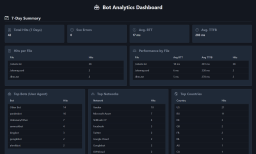Some Experiments into How Google's Crawler works
Why experiment with Googlebot Beyond the fact it is interesting to understand how it works, it is potential useful if you ca...
Expert insights, guides, and tips to improve your website's SEO performance
The internet has billions of web pages. Have you ever wondered how these are turned into a database that you can search? Or how The Crawl Tool gathers information to help improve user experience and search engine rankings? This post delves into the world of website crawlers: what are they? How do they work? What are the benefits? What is a crawler in the search engine world?
A website crawler traverses the internet or a website systematically. They are also sometimes referred to as a web crawler, spider, or a bot (short for robot). It acts like a digital librarian, browsing and indexing websites to be able to easily retrieve information in the future. A crawler will follow the links from one page to other pages, collecting the information and building a database (otherwise known as an "index").
For search engine optimisation we want our pages to rank higher. But we also want them to be found. Crawlers are therefore integral to the SEO process. We want our pages to be found! When a crawler visits a website it examines not only the links, but also the content, keywords, meta data, and other SEO elements. By understanding this information the search engine can rank the pages.
Understanding how a web crawler works helps to understand their importance and how various aspects of SEO effect the visibility of your pages. A crawler's process can be broken down into several stages:
Discover - The crawler starts with a list of URLs. These can be URLs it has found from a previous crawl, URLs from another source (such as a sitemap), or simply a list of URLs that the programmers assume are a good starting point. These form an initial queue of URLs to crawl.
Crawling - The crawler visits each URL on the list. It downloads the content of the page and extracts any hyperlinks it finds. Assuming it is allowed to follow the link, it adds it to the queue of URLs to crawl.
Parsing - The downloaded page is parsed for data that the crawler developers consider could be useful later for search results. Think here things like title tags, meta tags, all the way to the words in the actual page.
Indexing - Using the parsed data, an index is built. The index is all the useful data gathered in the parsing phase, but organized in a way that is very quick for the search engine to query.
Understanding the behavior of website crawlers helps to understand the connection and importance to SEO for website owners. Many aspects are related, some key ones are:
Technical SEO - Having good internal linking and a fast site helps crawlers to access and index your site quicker. Not only does it help with ranking, but a site that is easier and faster for a crawler to navigate helps it index more pages.
Sitemap - Having a sitemap helps the crawler to identify pages on your website with less work. Helping to make your pages more visible.
Robots.txt - With a robots.txt you can control which pages a crawler should or should not visit. This is useful for directing the crawler so it crawls the pages you want, rather than crawling pages that don't have much value in appearing in search engine results.
An SEO crawler like The Crawl Tool, also known as an SEO audit tool, essentially simulates the crawling process on the level of a single website and builds it's own database and data. This makes them instrumental in finding issues that may be affecting your search rankings.
Broken Links and 404 Errors - Clicking on a link and getting a 404 error is annoying for users. Remember that search engines want to rank sites with great user experience. Crawlers also waste time following them, when they could be crawling another great page on your site. Broken Links are, therefore, something you should be fixing regularly on your site and tools like The Crawl Tool with its Broken Link report are instrumental to this.
Duplicate Content - Duplicate content confuses search engines. They obviously don't want two results that are the same but where duplicate content exists it is a very difficult problem for them to know which they should include and which they should not. Also, as only one of the pages can be included, it is waste of crawler budget to have them crawl two pages the same. You should change one of them.
Meta Tag Issues - While the meta keywords tag isn't so important anymore, the meta description tag is used and the various social media tags are too. An SEO crawler can help you identify problems with these.
Internal Linking - An seo crawler tool can help you find issues with internal linking on your site. Does a page not show up that you were expecting? Then the page is not discoverable and you need to give it an internal link from somewhere. Are pages overlinked? Are there internal linking opportunities?
This has been a very short, high level, overview of search engine and seo crawlers, but hopefully better understanding how they work helps to understand their usefulness and the importance for search engine optimization.
Start with a free crawl of up to 1,000 URLs and get actionable insights today.
Try The Crawl Tool Free
Why experiment with Googlebot Beyond the fact it is interesting to understand how it works, it is potential useful if you ca...

LLMS.TXT again I've written about LLMS.TXT in the article about how getting one listed in an llms.txt directory mysteriously...

What's this about Adding Other Media to robots.txt I recently came across John Mueller's (a Google Search advocate) blog. I ...

Understanding the Importance of having a fast Mobile website I, personally, spend a lot of time focusing on site speed. The ...

What are robots.txt, sitemap.xml, and llms.txt These files are used by search engines and bots to discover content and to le...

AI Crawlers and Citing Sources The rise of AI, rather than search, crawlers visiting websites and "indexing" information is ...